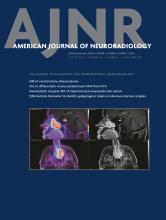We thank Drs Mese and Altintas Taslicay for their interest in our work on imaging signs of orbital compartment syndrome (OCS).1 First and foremost, we would like to stress again that OCS is primarily a clinical syndrome. If OCS has already been diagnosed on the basis of the physical examination, emergency decompression must not be delayed by any imaging study or by other diagnostic tests. Imaging can play a role when the clinical examination is limited (eg, by profuse periorbital hematoma), but any time delay inherent to performing imaging must be carefully weighed against the relatively small risks associated with the decompression procedure. Apart from that, radiologists should be aware of the typical imaging signs (proptosis, optic nerve stretching, and, in some cases, posterior globe tenting) so that they can alert the clinical team to the possible presence of OCS in cases in which this vision-threatening condition was not primarily suspected.
Our study investigated imaging findings of OCS before treatment and focused on CT imaging because this is the primary imaging technique for maxillofacial/orbital trauma. Furthermore, the ability to retrospectively reformat CT data sets proved useful for precisely comparing the affected orbit with the contralateral (control) orbit in a systematic manner.
The published literature on sonography in the context of OCS is very limited. However, it can be expected that the imaging phenotype that has been established on the basis of CT is generally transferrable to sonography, provided that the pertinent anatomy can be visualized. One should be cautioned that intraorbital emphysema or practical difficulties in the context of open injuries will limit the acoustic window in some cases. As is always the case, the choice of imaging technique must be informed by the respective strengths and weaknesses of each technique and will also be influenced by institutional factors such as availability and local expertise. Using sonography for the serial follow-up of OCS after treatment is an interesting proposition that would require dedicated investigation.
Reference
- 1.↵
- © 2023 by American Journal of Neuroradiology












